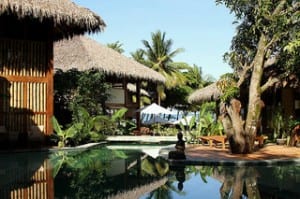 This novel idea is the latest twist in the eco-friendly hospitality
movement that not only benefits the hotel, but gets guests involved in a
real-time personal way.
This novel idea is the latest twist in the eco-friendly hospitality
movement that not only benefits the hotel, but gets guests involved in a
real-time personal way. Eco-consciousness as a buzzword has turned into a billion-dollar business ranging from everything from the hospitality and tourism industries to clothing, cosmetics, cars, cleaning products, and corporate philosophies.In technology, you’ve got solar-powered laptops, bamboo iPhone cases, and now a new eco-friendly light bulb called LIFX LED that you can manipulate its color and brightness from your smartphone via WIFi. You can even match the light’s settings to the songs on your playlist. How geeky is that?
Earth-conscientious travelers are more frequently seeking out eco-friendly lodging. Boutique hotels are at the forefront of this trend. The most common environmental practices include: Guest towel & linen re-use LED and compact fluorescent lighting to save energy Water-efficient toilets and showerheads Reduce waste output Reduce energy & water use Reduce carbon footprint Eliminate pollution No pesticides in the gardens Window films (like Huper Optik films) that reduce energy usage and protect furniture, carpets, paint, etc. against fading Costa Rica is a hot ecotourism destinationIn ecotourism hotspot Costa Rica, Pranamar Villas is a leading boutique hotel for planet-conscious places to stay.
The oceanfront holistic yoga-surf hotel on the Nicoya Peninsula's top-rated Santa Teresa Beach isn’t just “greenwashed” (eco-friendly in advertising only). Owners and staff are committed to following a long list of environmental practices every day.
 Pranamar’s lush tropical gardens are completely organic; they use no
herbicides or pesticides on the property. Much of the vegetation is
“edible” – fruits, vegetables and Pranamar's organic restaurant uses
fruits, vegetables and herbs grown at the hotelherbs that supply the
open-air restaurant with fresh, healthy cuisine. They grow mango,
papaya, banana, starfruit, guanabana, passion fruit and Suriname
cherries. During the dry season, melons and squashes underneath
ornamental and fruit trees provide ground cover to help hold moisture.
Pranamar’s lush tropical gardens are completely organic; they use no
herbicides or pesticides on the property. Much of the vegetation is
“edible” – fruits, vegetables and Pranamar's organic restaurant uses
fruits, vegetables and herbs grown at the hotelherbs that supply the
open-air restaurant with fresh, healthy cuisine. They grow mango,
papaya, banana, starfruit, guanabana, passion fruit and Suriname
cherries. During the dry season, melons and squashes underneath
ornamental and fruit trees provide ground cover to help hold moisture. The herb and vegetable garden flourishes with mint, basil, oregano, rosemary, thyme, tarragon, turmeric, arugula, mustard greens, tomatoes, chili peppers, okra, cucumber and eggplant. The hotel’s composting system completes the food cycle by turning the restaurant’s organic waste into natural fertilizer. All soaps, laundry detergent, cleaning supplies, and even guests’ amenity shampoos, conditioners and bath soaps are biodegradable. Energy-saving light bulbs and appliances reduce electricity usage. Even the free-form swimming pool is eco-conscious: it’s filled with salt-water, meanPranamar's salt water pool is chlorine freeing less chlorine and other chemicals.


